Star Trek Generations
Written by Rick Berman and Ronald D. Moore & Brannon Braga
Directed by David Carson
Release date: November 18, 1994
Stardate: 48632.4
Captain’s log. A bottle floats through space and breaks on the U.S.S. Enterprise, NCC-1701-B. Joining Captain John Harriman on her maiden voyage is a gaggle of press, as well as Kirk, Scotty, and Chekov. The trio look around and talk to the helm officer, Ensign Demora Sulu, Hikaru Sulu’s daughter.
After Kirk gives the order to leave Spacedock—which he only does reluctantly, and only after Harriman insists—they set course for a trip around the solar system. However, they pick up a distress call. Two ships are stuck in an energy ribbon and are about to be destroyed. Harriman tries to fob it off on another ship in range—but there is no other ship in range, so Harriman reluctantly sets course. Throughout all this, Kirk is practically jumping out of his skin.
When they arrive, they can’t get close enough to transport without getting sucked into the ribbon. The ship’s tractor beam and photon torpedoes won’t be installed until Tuesday, and the medical staff doesn’t report until then, either, which is why Harriman was reluctant to enact a rescue. They manage to beam 47 of the 300 people on the two ships away before they’re destroyed—and then the Enterprise itself is being torn apart by the gravimetric forces of the ribbon.
Since there’s no medical staff, Chekov and a couple of reporters take care of the refugees, one of whom, Soran, is beside himself wanting to go back for some reason. Another we recognize as Guinan.
Scotty thinks that an antimatter blast will disrupt the gravimetric field, but without photon torpedoes, that’s hard to manage. The deflector can be gimmicked to simulate a torpedo, though. Harriman is about to do it, leaving Kirk in charge. Kirk eagerly sits in the center seat at first, then thinks better of it, telling Harriman that his place is on the bridge of his ship.
Kirk goes to deck 15 to do what needs doing. Demora activates the deflector when he’s done, and they break free, but a backwash from the ribbon hits decks 13-15, including the section where Kirk was. Scotty, Chekov, and Harriman go down to find the hull breached, and no sign of Kirk.
Seventy-eight years later, a promotion celebration is held on the holodeck of the Enterprise-D, with a sailing ship—also called Enterprise—re-created and the crew in 18th-century sailing outfits. Worf is treated as a prisoner, the charges against him being performing above and beyond the call of duty and earning their respect. Picard then promotes him to lieutenant commander, “And may God have mercy on your soul.”
Worf then has to walk the plank and snatch the tricorn hat from a bit of rigging. Riker then “accidentally” removes the plank rather than retract it, and Worf falls into the water. Data doesn’t get the humor of the situation and asks Crusher to explain it. Her explanation inspires him to push Crusher into the water, which everyone in the audience thinks is hilarious, but nobody on the ship does for reasons the script never adequately explains.
The festivities are interrupted twice, first by Picard receiving a personal message that his brother and nephew have died in a fire, then a distress call from the Amargosa Observatory that they’re under attack. Everyone leaves the holodeck and the Enterprise-D goes to red alert.
When they arrive, there are no ships in the area and the observatory is in bad shape. Only five of the nineteen crew members assigned to the observatory have survived. Riker takes an away team over with Worf, Crusher, and a security detail. One of the people they rescue is Soran. They find two Romulan corpses as well, which indicates that they were the ones who attacked.
On the Enterprise, Data views his difficulty with humor as a reason to finally install the emotion chip that Dr. Soong made for him and that Lore stole. (Never mind that the difficulty was with everyone else, as what he did was funny! It was even the same kind of funny as what Riker did to Worf!) Meanwhile, Soran goes to Picard and insists that he return to the observatory to complete an experiment, but Picard won’t let him until the investigation is complete. Soran then says some crazy-ass things that would do absolutely nothing to convince anyone to let him do what he wants, which makes you wonder why he said it. He also avoids Guinan’s gaze for fear of being recognized.
Worf’s investigation reveals that the Romulans were looking for information on trilithium, even though that wasn’t part of the observatory’s remit. La Forge and Data beam over to try to find traces of trilithium, and they don’t find any, though Data does finally get a joke La Forge told seven years earlier. However, they do find a hidden door that Data gets open, revealing a hidden lab. Before they can investigate, Data is overwhelmed by his emotion chip—then Soran inexplicably shows up and ambushes La Forge and threatens Data so that now he’s overwhelmed with fear.
On the Enterprise, Troi checks up on Picard, who finally reveals that Robert and René died in a fire. He laments the end of the Picard line—because, apparently he’s sterile? I dunno. Anyhow, they’re interrupted by the sun imploding. A shockwave is going to destroy the observatory, and La Forge and Data are still on it. Riker and Worf try to enact a rescue but Soran fires on them, then beams to a Klingon ship that has just decloaked, along with La Forge. Data is cringing in fear, but he, Riker, and Worf beam back before the shockwave hits.
Soran is in league with Lursa and B’Etor, who are still trying to put themselves in position to rule the Klingon Empire. They stole the trilithium from the Romulans for Soran, which is why they attacked the observatory. He wants to figure out a way to destroy suns for his own reasons, and the Duras sisters are aiding him so they will have a powerful weapon.
Crusher has found Soran’s Wikipedia entry and discovers his connection to Guinan. According to Guinan, the ribbon isn’t just a spatial phenomenon, it’s a gateway to a place called the Nexus, a place of total joy. Soran has been trying to get back there, but Guinan has no idea how destroying suns would further that goal.
Picard and Data work through the problem, and they realize that he’s destroying suns in order to affect gravitational fields in the vicinity, which will change the ribbon’s course so that it will hit a planet. Soran plans to be on that planet—Veridian III—in order to reenter the Nexus. He’ll destroy Veridian’s sun, which will send the ribbon to the planet. Unfortunately, that will shortly thereafter destroy all the planets in the Veridian system, including the fourth planet, which has more than two hundred million people on it.
Soran has modified La Forge’s VISOR, and then gives Lursa and B’Etor the secret to the sun-killer before beaming down to Veridian III. Picard negotiates with Lursa and B’Etor to return La Forge in exchange for Picard himself as a prisoner—but only after he beams down to talk to Soran. They agree, mainly because they put a camera on the VISOR. Through La Forge, they’re able to find out the ship’s shield frequency and fire their torpedoes through the shields. Data, Worf, and Riker manage to figure out a way to remotely engage their cloaking device, which lowers their shields long enough for Worf to fire a torpedo, which destroys them, but not until after the Klingons have pounded the shit out of the defenseless Enterprise.
Picard’s attempts to talk Soran out of his destructive course fail, and Picard can’t get through the force field Soran has protecting himself. However, Picard does find a way under it, which he crawls under once Soran isn’t looking.
Meanwhile, the Enterprise took too much damage. The warp core loses containment. Riker evacuates everyone from the drive section into the saucer and they separate, but they can’t get far enough away from the drive section before the breach. The saucer is damaged in the explosion and crash lands on Veridian III.
Soran and Picard get into a fistfight on a catwalk. Soran wins and then the probe launches, destroying the sun and sending the ribbon to Veridian III. Both Soran and Picard are swallowed up by the ribbon and sent to the Nexus.
Seconds later, Veridian III and the Enterprise saucer are destroyed.
Picard finds himself in a beautiful Victorian house in the midst of a Christmas celebration with his wife and many children, nieces, and nephews—including René, alive again.
However, the twinkle of the ornaments reminds him of a sun going nova, and he knows this isn’t real. He encounters Guinan, dressed as she was when the Enterprise-B rescued her—in truth, it’s an echo of her from when she was in the Nexus. While he is reluctant to leave his newly discovered family, his sense of duty takes over and he insists he has to go back so he can confront Soran again.
Guinan can’t go back with him—she’s not really there—but there’s someone else who is there: Kirk.
Picard finds him chopping wood outside a rustic cabin in the middle of the mountains. Kirk is confused, as he sold the cabin years ago. To his surprise, his ex Antonia is there, and his dog Butler is there as well, even though he died seven years earlier.
Kirk finally realizes that he’s returned to the day he told Antonia he was going back to Starfleet. Picard tries to convince him to return to Veridian III with him. Kirk, though, has been informed that history believes him to be dead, and who is he to argue with history?
He goes to bring Antonia her breakfast, but instead of telling her he’s going back to Starfleet, he’s going to tell her that he’s going to stay with her—
—except that doesn’t work. Instead, they both wind up at Kirk’s uncle’s stables, which is the day he met Antonia. He rides off to do so, and Picard follows on another horse. Kirk makes a jump with the horse that he made dozens of times, and it always scared him—but this time it doesn’t, because it isn’t real.
Kirk decides to join Picard. They come out of the Nexus. The Enterprise crashes again. Soran goes to the catwalk again.
And this time he’s confronted by both Picard and Kirk. Soran manages to get away, and they give chase. Fisticuffs ensue, and Soran manages to cloak the launcher—but then he drops the controller. Kirk runs to the catwalk that the controller fell on, and Soran shoots it. Picard helps Kirk get off the catwalk safely, then they split up. Kirk goes for the controller while Picard goes for the launcher. Kirk manages to snag the controller and decloak the launcher, enabling Picard to clamp the launcher in place. When Soran chases him away from the launchpad, he runs to it only to be blown up when the launch sequence completes and the thing can’t fire.
Picard goes to where Kirk has been crushed by the fallen catwalk. Picard assures him that he helped save the day. Kirk says it was fun and then dies. Picard buries him, then is rescued by a Starfleet shuttlecraft.
Casualties were light in the crash, but the Enterprise isn’t salvageable. Three Starfleet ships rescue the crew and they head back home.
Can’t we just reverse the polarity? Even though they had to evacuate the ship once to get rid of trilithium resin, Riker and Worf talk like trilithium is a new thing. It will be seen as an explosive moving forward, and I guess it’s 50% more lithium-y than dilithium…
I cannot change the laws of physics! Scotty, of course, manages to beam some of the El-Aurian refugees away despite the temporal interference, and also comes up with a way to get the Enterprise-B away from the ribbon. He also takes great joy in tweaking Kirk.
It’s a Russian invention. After (re)introducing Kirk to Demora, Chekov insists that he was never that young. Kirk puts a friendly hand on his shoulder and says that he was younger.
Ahead warp one, aye. Sulu apparently had time for a family. This rather shocks Kirk.
Thank you, Counselor Obvious. Troi notices that Picard has had an emotional whammy as soon as he gets the e-mail that his brother and nephew are dead, but it takes her a bit to get him to actually open up about it.
If I only had a brain… Data implants his emotion chip. It doesn’t go so hot.
There is no honor in being pummeled. Worf gets a long-overdue promotion to lieutenant commander, a rank he’ll keep through the remaining films as well as his tenure on DS9. In honor of this, he finally gets a chair at tactical.
Syntheholics anonymous. Guinan spent some time in the Nexus after she was rescued following the Borg attack on her homeworld. She helps navigate Picard through it.
In the driver’s seat. Two different officers are seen at conn, but when the ship is crashing, Troi winds up taking the helm. Many imbeciles have used this as an excuse to ding Troi—ha ha, the counselor flew the ship and it crashed—but it was gonna crash no matter what. While she was flying it, the ship landed somewhat safely with what Picard described in his log entry at the end as minimal casualties. That’s actually good piloting.
No sex, please, we’re Starfleet. Picard goes on at some length to Troi about how the Picard line ends with him. No news on when Picard got the vasectomy…
Channel open. “Just imagine what it was like—no engines, no computers, just the wind and the sea and the stars to guide you.”
“Bad food. Brutal discipline. No women.”
Picard being romantic about sailing ships, with Riker being a bit more realistic.
Welcome aboard. Back for more are William Shatner, James Doohan, and Walter Koenig, starring alongside Sir Patrick Stewart, Jonathan Frakes, Brent Spiner, LeVar Burton, Michael Dorn, Gates McFadden, Marina Sirtis, Patti Yasutake, and an uncredited Whoopi Goldberg, the latter nine reprising their roles from Star Trek: The Next Generation.
Alan Ruck—probably best known as Cameron in Ferris Bueller’s Day Off, though his resumé is far more extensive—plays Harrisman while Jacqueline Kim—probably best known as Lao Ma on Xena: Warrior Princess—plays Demora. The rest of Harriman’s crew is played by Jenette Goldstein—probably best known as Vazquez in Aliens—and Trek veterans Tim Russ (Tuvok on Voyager, as well as guest roles on TNG‘s “Starship Mine” and DS9‘s “Invasive Procedures“), Thomas Kopache (TNG‘s “The Next Phase” and “Emergence,” DS9‘s “Ties of Blood and Water” and “Wrongs Darker than Death or Night,” Voyager‘s “The Thaw,” and Enterprise‘s “Broken Bow” and “Harbinger”), and Glenn Morshower (TNG‘s “Peak Performance” and “Starship Mine,” Voyager‘s “Resistance,” and Enterprise‘s “North Star”). In addition, one of the journalists is played by John Putch, who played two different Benzites in TNG‘s “Coming of Age” and “A Matter of Honor.”
Barbara March and Gwynyth Walsh make their final appearances as Lursa and B’Etor, following TNG‘s “Redemption,” “Redemption II,” and “Firstborn” and DS9‘s “Past Prologue.” Brian Thompson plays their helm officer; he appeared as various other aliens (including another Klingon) in TNG‘s “A Matter of Honor,” DS9‘s “Rules of Acquisition” and “To the Death,” and Enterprise‘s “Babel One”/”United”/”The Aenar” three-parter.
And finally, Malcolm McDowell plays Soran, the man who killed Captain Kirk. Lucky him.
Trivial matters: Famously, this movie went through a major reshoot of the ending when test audiences very much disliked the way Kirk died. It was re-shot at the last minute. The original ending can be found in J.M. Dillard’s novelization, which had already gone to press when the re-shoots were done. Dillard’s novel also included additional prologue material with Kirk, Scotty, and Chekov, as well as appearances by Spock, McCoy, Sulu, and Uhura. The movie also had a YA novelization by John Vornholt and a comics adaptation by Michael Jan Friedman & Gordon Purcell.
The prologue of this movie takes place about a year or so after The Undiscovered Country. As promised at the end of the previous film, the Enterprise-A was decommissioned, and this is the launch of the Enterprise-B. The main body of the film takes place about a year after “All Good Things…,” the final episode of TNG.
We finally get the missing Enterprise, as it were. “Encounter at Farpoint” established Picard’s ship as the Enterprise-D, with The Voyage Home having set that precedent with the Enterprise-A. The Enterprise-C was seen in “Yesterday’s Enterprise,” and we at last get the Enterprise-B here. The Enterprise-E will be established in First Contact.
This is the final appearance of William Shatner, Walter Koenig, and James Doohan as Kirk, Chekov, and Scotty, though Scotty’s next chronological appearance is in TNG‘s “Relics,” which aired in 1992. The characters will next appear in the 2009 Star Trek, played respectively by Chris Pine, Anton Yelchin, and Simon Pegg.
When Scotty is rescued from the Jenolen by the Enterprise-D in “Relics,” he posits that Kirk himself rescued him, which is at odds with Scotty being present for Kirk’s “death” here. Ronald D. Moore has said in interviews that it wasn’t worth trying to reconcile them, and he’s right.
When TNG wrapped, the studio always intended to bring these characters to the screen, with The Undiscovered Country having been the final outing for the original crew (at least in this timeline). Rick Berman wanted to do a passing of the baton, as it were, from the original series, and commissioned story pitches from several TNG past and present staffers—former show-runner Maurice Hurley, current show-runner Michael Piller, and current staffers Ronald D. Moore & Brannon Braga. Piller declined and the studio preferred Moore & Braga’s notion over Hurley’s.
Earlier drafts of the script called for the entire original crew, and later it was simplified to three, originally intended to be Kirk, Spock, and McCoy, with Kirk later interacting with the TNG crew. Both Leonard Nimoy and DeForest Kelley declined, so instead they got James Doohan and Walter Koenig, with Spock’s lines given to Doohan’s Scotty and McCoy’s to Koenig’s Chekov.
The studio’s first choice for director was Nimoy, but he declined to direct a Trek movie he had no say in the story of. Instead, they turned to veteran Trek TV director David Carson.
Internal dating on the movies themselves indicate that there’s roughly a decade of time between The Motion Picture and The Wrath of Khan. (The former was two-and-a-half years after the end of the five-year mission, the latter fifteen years after “Space Seed,” which was early in the 5YM.) This movie establishes that, for part of that time, Kirk retired and lived with a woman named Antonia. She’s seen in the distance, and played by stuntwoman Lynn Salvatori. In her honor, the character was given the last name of Salvatori when she was seen in tie-in fiction, particularly the Crucible trilogy by David R. George III. She’s also referenced in Christopher L. Bennett’s The Darkness Drops Again (part of the Mere Anarchy miniseries) and Dayton Ward’s Elusive Salvation.
The backstory for Demora was provided in Peter David’s novel The Captain’s Daughter, which also did a certain amount to redeem the character of Harriman. Harriman, Demora, and the Enterprise-B were further seen in David’s short story “Shakedown” in Enterprise Logs, David R. George III’s Lost Era novels Serpent Among the Ruins and One Constant Star and his short story “Iron and Sacrifice” in Tales from the Captain’s Table, Andy Mangels & Michael A. Martin’s novel Forged in Fire, and in the comic books Alien Spotlight: Klingons by your humble rewatcher and JK Woodward, Captain’s Log: Harriman by Marc Guggenheim & Andrew Currie, and Spock: Reflections by Scott & David Tipton, David Messina, & Federica Manfredi. Demora will next be seen as a child in Star Trek Beyond.
Several works of tie-in fiction deal with the fallout from Kirk’s apparent death in the prologue, among them the novels Vulcan’s Forge by Josepha Sherman & Susan Shwartz, The Ashes of Eden and The Return by William Shatner with Judith & Garfield Reeves-Stevens, Engines of Destiny by Gene DeWeese, and the aforementioned The Captain’s Daughter, the novella Its Hour Come Round by Margaret Wander Bonanno (part of the Mere Anarchy miniseries), the aforementioned Crucible trilogy, and the aforementioned comic book Captain’s Log: Harriman.
Up until this film, TNG and DS9 were filmed as if starbase personnel wore the turtleneck uniforms seen in DS9 while starship and headquarters personnel wore the TNG uniforms (as evidenced by Sisko switching to a TNG uniform when he was assigned to Earth in “Homefront” and “Paradise Lost“). However, Starfleet personnel in this movie wore the TNG and DS9 uniforms interchangeably, and Voyager would have everyone assigned to that ship wearing the DS9 uniforms. So not confusing at all.
Neither Jeremy Kemp nor David Tristan Birkin, who played Robert and René Picard in “Family,” were used for the photographs Picard looks at. Instead, uncredited actors played the two roles.
The El-Aurian refugees found by the Enterprise-B are fleeing a Borg attack on their homeworld, which was previously referenced by Guinan in “Q Who.”
Data’s emotion chip first appeared in “Brothers,” and Data acquired it in the “Descent” two-parter. Despite this movie establishing that the chip is permanently fused to his neural net and unable to be switched off, he will switch it off in First Contact and remove it in Insurrection. It isn’t even acknowledged in Nemesis. The evolution of the emotion chip is dealt with in the short story “Friends with the Sparrows” by Christopher L. Bennett (in the anthology The Sky’s the Limit) and the novella The Insolence of Office by William Leisner (part of the Slings and Arrows miniseries). Leisner’s novella also deals with La Forge switching from the VISOR to optical implants, done in part due to the VISOR being used against him in this movie.
In “The Chase,” Picard is given a Kurlan naiskos by his mentor and father figure, Dr. Richard Galen. He goes on at some length about how rare it is and how honored he is to be given this amazing gift from a person to whom he was truly closer than his own biological father. So it’s rather disheartening to see him casually toss the naiskos aside in the wreckage of the Enterprise-D…
A cut bit of dialogue establishes that Guinan’s sensitivity to temporal mechanics, as seen in “Yesterday’s Enterprise,” is because of her time in the Nexus.
In Lursa and B’Etor’s previous appearance in “Firstborn,” Lursa was pregnant with a son. That son’s fate is unclear, though the Star Trek Online game establishes the son, named Ja’rod after Lursa’s father, is alive and serving the empire.
In the tie-in fiction and Star Trek Online, Picard and Crusher marry some time after Nemesis, and they have a son, named René. So not the end of the Picard line after all…
To boldly go. “I hate this! It is revolting!” When I first saw this movie in 1994, my first thought was that it was a promising first draft that was rushed into production. This is mostly because it was a promising first draft that was rushed into production. Ronald D. Moore and Brannon Braga wrote this in about seven-and-a-half minutes, at the same time that they were writing the (much much better) “All Good Things…” and then the movie was slammed into production right after TNG wrapped production as a TV show.
This rushed nature is seen most obviously in the visuals. The sets and costumes and props were all designed to be seen on a small screen—and this was before the days of high-definition TV, remember—so despite David Carson turning all the lights down all over the Enterprise, they still look chintzy. So does La Forge’s VISOR (I still remember chortling twenty-three years ago during the discussion of Data’s emotion chip when you can see LeVar Burton’s eyes blinking through the slats of the VISOR in closeup).
But the main place it’s seen is the script. There are good themes here, ones involving emotions and how you handle them, of the passage of time and how it affects one, of life and death and loss. Precisely none of those themes are handled well. Data’s journey through his emotion chip should have been linked to Picard’s grief over his family instead of being relegated to an idiotic low-comedy subplot. (It didn’t help that the whole thing was inspired by Data apparently not getting humor even though he did something incredibly funny! C’mon, pushing Crusher into the water was fucking hilarious!)
Soran has no bite to him as a villain. Malcolm McDowell does the best he can, but we don’t know what he went through in the Nexus beyond quick, cursory mentions by Crusher and Picard, and he’s just a guy being nasty. Snore.
Lursa and B’Etor are mainly there as a vehicle by which they can destroy the Enterprise and build a new one that looks good on a movie screen next time.
Picard’s Nexus experience makes absolutely no sense. It feels like it was inspired by Sir Patrick Stewart’s regular gig of doing a one-person performance of A Christmas Carol, but while a Victorian Christmas with a wife who cooks goose and a bunch of moppets might be a cute experience for Stewart, there’s nothing about it that says, “Jean-Luc Picard.” And why is he bemoaning the end of the Picard line? Why isn’t he using Robert and René’s death as the impetus to finally grab Crusher, kiss her on the mouth, and go make babies? Sheesh.
The one way in which this movie shines is in the prologue. The Enterprise-B launch-as-photo-op is very well done. Alan Ruck deserves a ton of credit here, as he’s obviously been put in a terrible position, trying to mount a rescue with a half-empty, half-finished ship. While it would’ve been nice to see Spock and McCoy alongside Kirk, Scotty and Chekov work just fine—the entire crew has been together long enough that it’s just as funny to see Chekov and Scotty snarking off Kirk after he says, “Take her out” to thunderous applause, and Kirk grumbling, “Oh, be quiet.”
In general, the interactions among the 23rd-century folk work beautifully. Shatner is especially good, amused by the whole spectacle, and then wanting desperately to take over when the crisis hits. Not to mention the moment when he stops Harriman from modifying the deflector, knowing that it’s Harriman’s ship, not his.
Also Kirk’s Nexus experience is interesting. There’s this big honking gap between The Motion Picture and The Wrath of Khan when Kirk went from being back in the center seat to go exploring to a desk job with the Enterprise as a training ship with Spock as her captain. While lots of people have, unimaginatively, in my opinion, posited a second five-year mission for that timeframe (it just doesn’t strike me as being that interesting, to have them do exactly what they did before), there’s lots of things they could have been doing in that decade, and even if you do put another 5YM in there, that could have resulted in Kirk having the ship taken away again and him deciding to retire and live with Antonia for a while before the siren call of the center seat came back.
I also like Kirk’s advice to Picard about how the big chair is where you can make a difference and you should never give it up.
The final battle of Kirk and Picard vs. Soran is spectacularly uninteresting. Lots of people have complained that it was a lousy death for Kirk, but there’s no such thing as a good death, and at least he helped save a solar system that included two hundred million inhabitants. No, it’s just that the whole thing is just perfunctory and boring and full of middle-aged men flailing on catwalks and bleah. Shatner, at least, is having fun with it—”Call me Jim!”—which is pretty much all that’s memorable about it.
Speaking of things that aren’t memorable, man, do the Trek movies have trouble coming up with things to call their planet-threatening menaces. I mean, we start with “V’ger,” which sounds like a badly thought out comic book sound effect, then we have “the probe,” and now we have “the ribbon.” What’s next, the doily?
Also, if Picard could leave the Nexus any time, why not come back to Ten-Forward when he first met Soran, only this time come with a security detail and throw his ass in the brig? As it is, we never do find out how Soran managed to beam off the Enterprise to the observatory to capture La Forge without anyone noticing. Then again, nobody noticed that Soran put a frickin’ camera on La Forge’s VISOR, either…
This basic story could have made a good movie. The themes could have been tied together much better. We could have had a proper exploration of the Nexus as a place where your dreams come true, but it’s all hollow unless you embrace it. It’s interesting that the long-lived El-Aurians so totally embraced it while the much shorter-lived humans didn’t. There’s perhaps something to that that a script that actually had had some time spent working on it might have been able to do something with.
Warp factor rating: 2
In two weeks: Star Trek (2009)
Rewatcher’s note: We’ll be taking Independence Day off, returning with the Bad Robot TOS films on the 11th of July.
Keith R.A. DeCandido will be the Toastmaster at InConJunction XXXVII in Indianapolis this weekend, alongside Guests of Honor Mercedes Lackey, Larry Dixon, Marc Gunn, Shonna Bedford, Michelle Mussoni, Kimberly Richey, and more. Check his schedule out here.










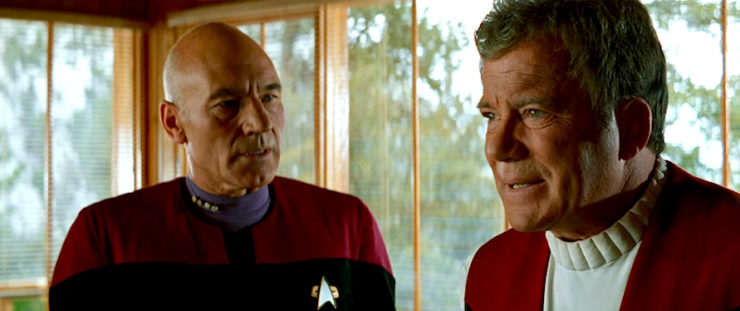
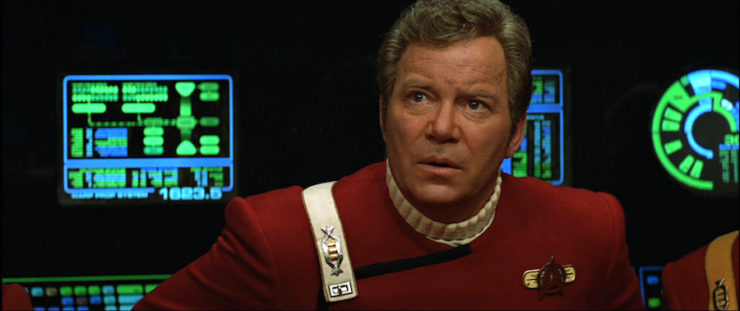
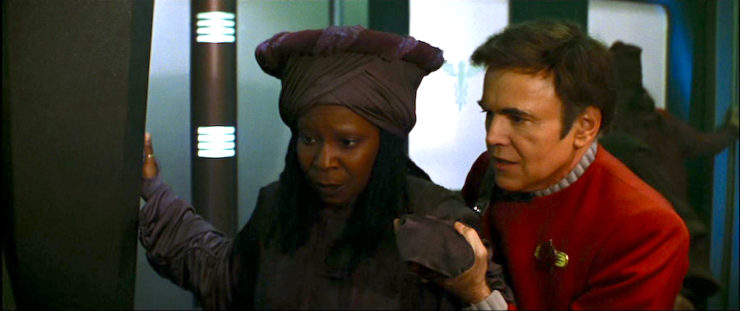
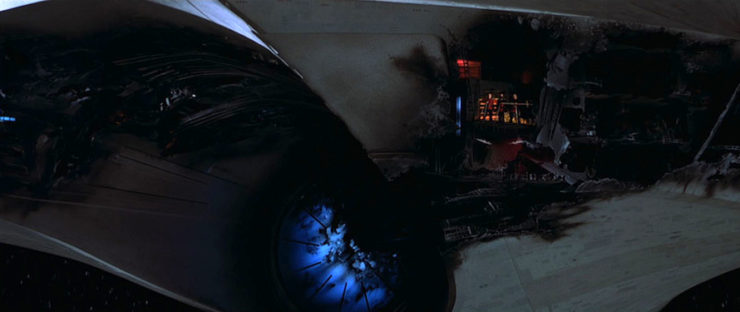
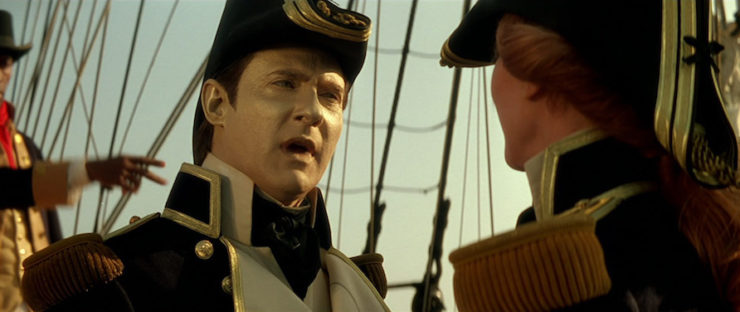
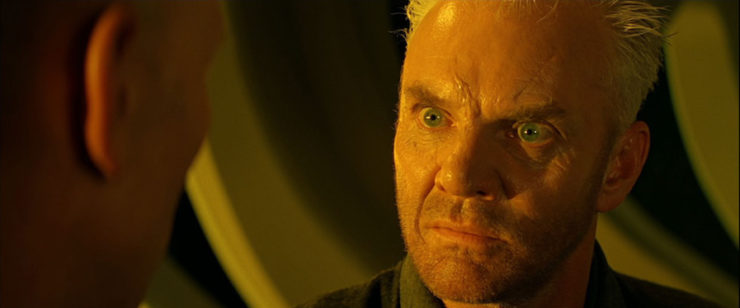

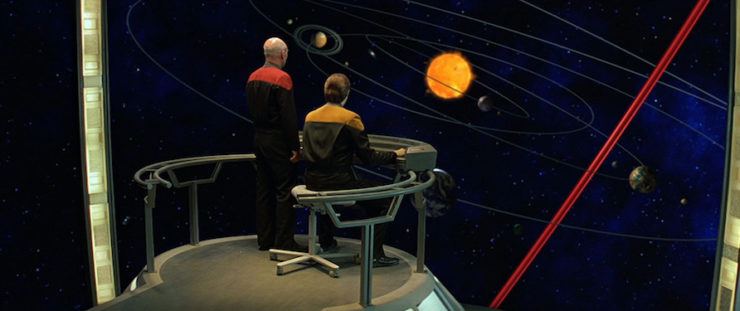
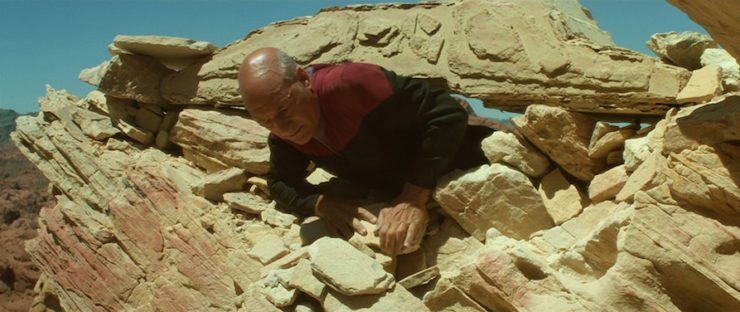
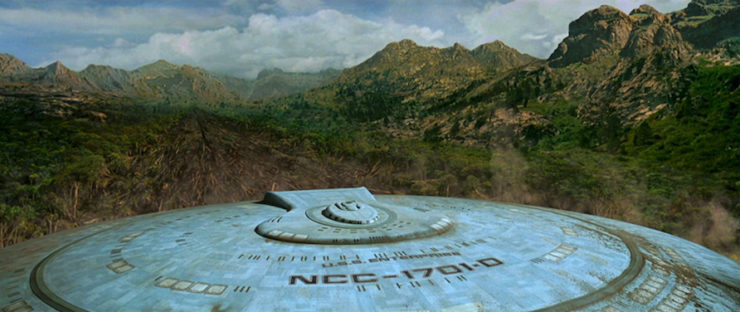


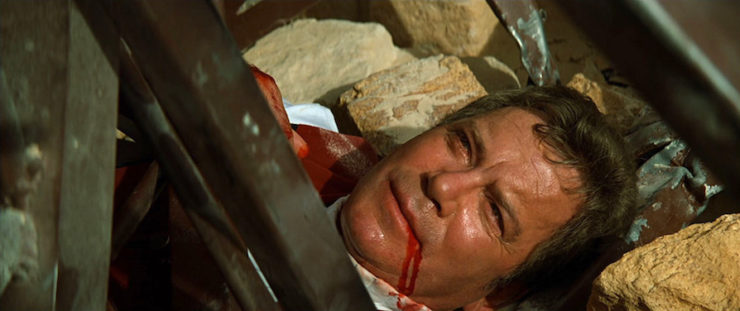
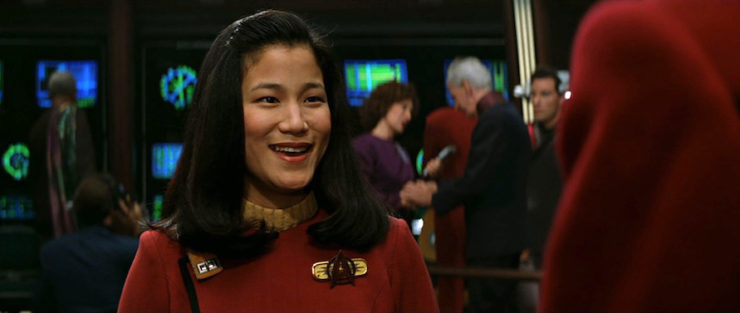
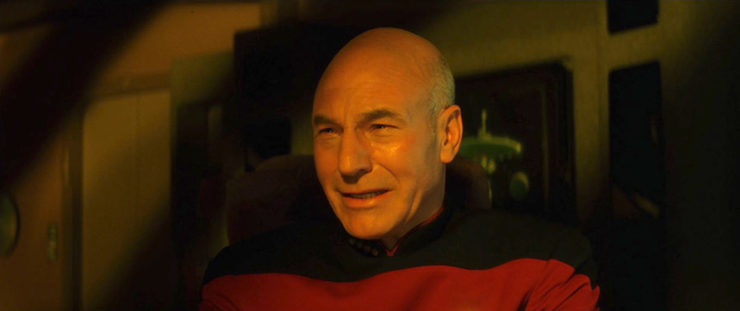
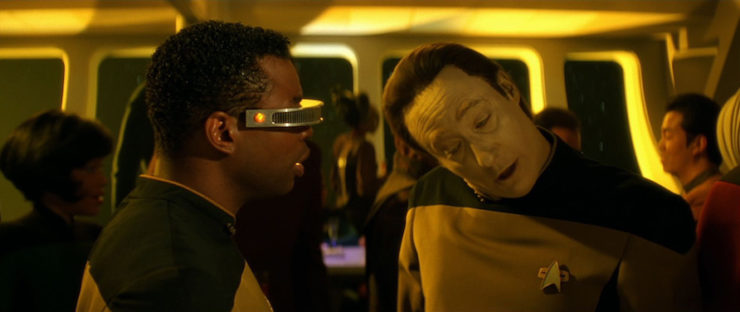
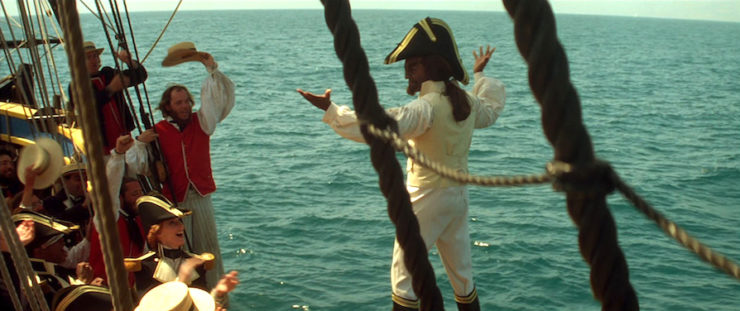
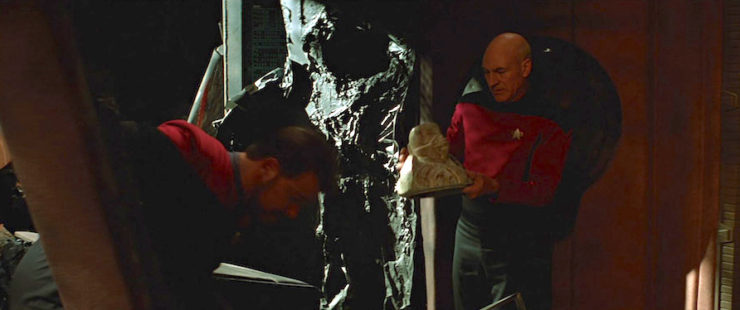
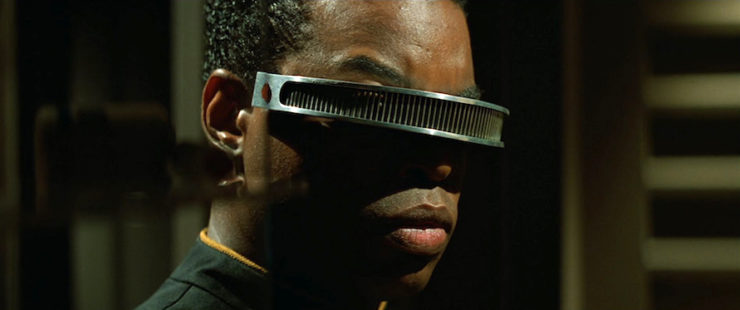
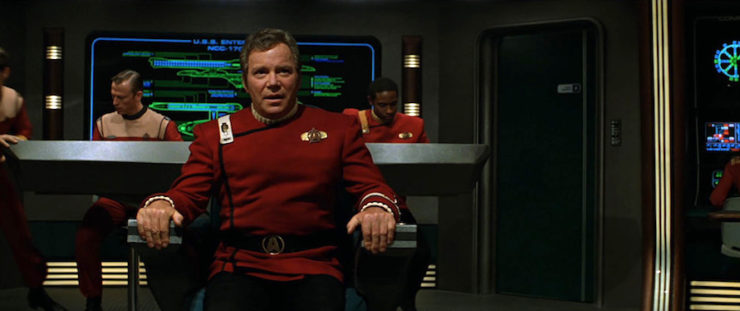
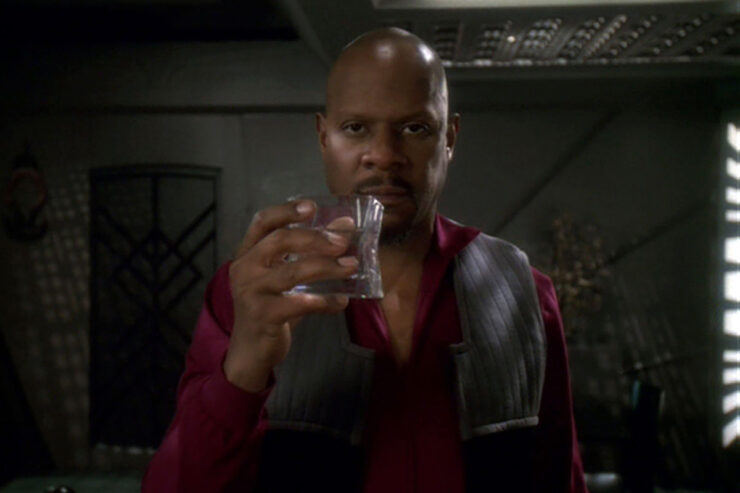
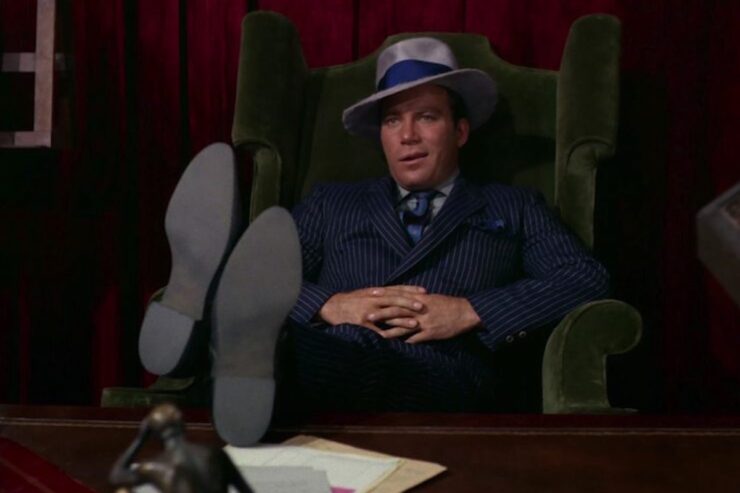
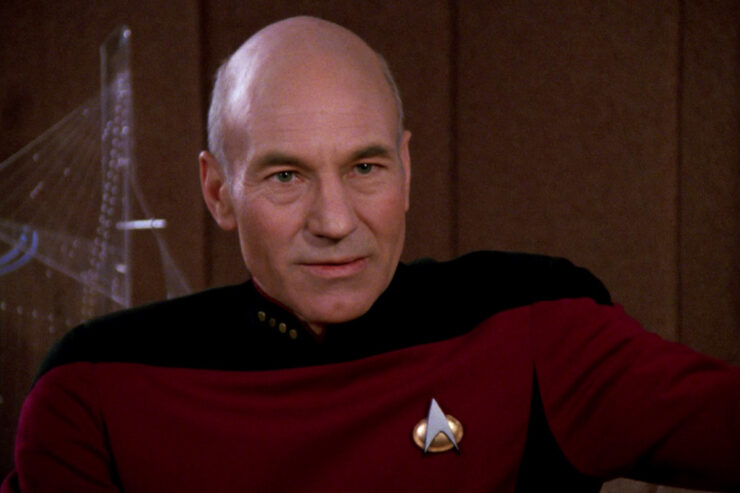
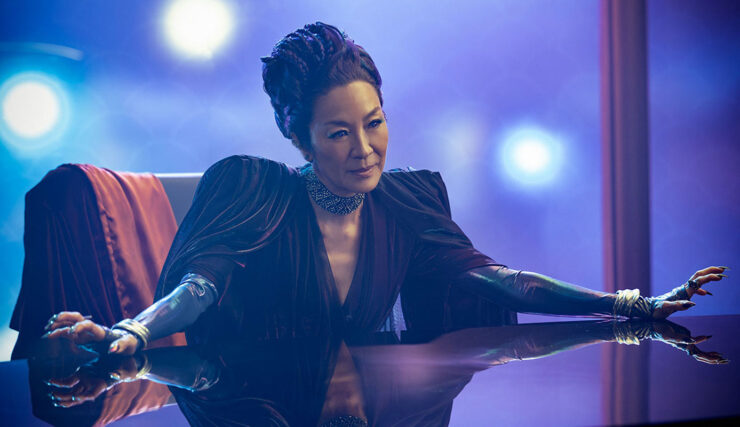
I was really looking forward to your re-watch articles. Unfortunately you’ve managed to pick apart almost the entire series with inane details and making mountains out of mole hills (for example the ridiculous paragraph above regarding turtlenecks…really?). Generations while by no means a great film deserves better than a 2. However that is an appropriate rating for your reviews.
I liked this film when I first saw it — the saucer crash in particular was breathtaking in the theater, and it was great that the producers finally let Dennis McCarthy write melodies again and really go all-out with his most unforgettable score — but there’s a lot that bugs me about it in retrospect. The Nexus makes no damn sense. If it orbits the whole galaxy in just 78 years — something that takes Earth 200 million years to do — then it should be moving far, far faster than light, which means it could never be moving slowly enough for its approach to be naked-eye visible from a planet surface. And why is it so hard to get into that Soran has to blow up stars, when his ship had no trouble stumbling into it by accident the first time around? Besides which, gravity propagates at the speed of light, and blowing up a star wouldn’t actually change the location of its center of mass anyway unless the explosion was very asymmetrical, so the supernovae should not have had an instant effect on ships and phenomena parsecs away. There’s another speed-of-light problem when Picard and Soran see the Veridian sun blow up moments after the torpedo launch. Realistically, they would’ve just had to stand there waiting for several minutes for the light to reach them — unless Veridian is a very tight red-dwarf system like TRAPPIST-1 with the planets a fraction of an AU from the star, in which case the visual lag would be maybe 15-20 seconds. But getting something as tiny as a red dwarf to go supernova would be even harder than getting a Sunlike star to do it.
But I disagree with a lot of the criticisms about the film. In particular, I disagree with the idea that Kirk’s death was somehow “unworthy.” Kirk wouldn’t have cared how glamorously he went out; he was just a guy doing his duty, trying to help people. He gave his life to save other lives, and that was certainly worthy. In particular, look at how it happens. He’s on a bridge that almost collapses. He comes within a hair’s breadth of falling, and Picard saves him. And then, without a moment’s hesitation, he strides right back out onto the bridge that almost killed him seconds before, because he still has a goddamn job to do and he’s gonna finish it or die trying. That is the most quintessentially Kirk thing imaginable. The moment is so throwaway that it’s easy to miss, but that very casualness with which Kirk climbs back into the lion’s mouth is exactly what’s so extraordinary about it. He made an understated, un-melodramatic, matter-of-fact choice to give his life for others, and that is absolutely fitting for the real James T. Kirk, as opposed to the nonsense caricature of him that pop culture has created.
Oh, and Keith, I share your contempt for the “Troi is a terrible driver” jokes, but what you leave out is that those jokes aren’t just about the counselor steering the ship — they’re about her being a woman. They’re based on the antiquated tradition of sexist jokes about “women drivers” and their alleged incompetence. And I find them utterly loathsome. You’re right — bringing that gigantic structure all the way down from orbit and landing it safely is an incredibly good job of piloting, particularly for someone who doesn’t specialize in the field. One can surmise she had a lot of computer assistance, but she still saved the lives of over a thousand people, and it’s obscene that so many people would rather twist that into an excuse for an outdated misogynistic joke.
As for why Picard couldn’t go back in time to an earlier point in the movie, my supposition has always been that the trips through “time” within the Nexus, like Kirk being in the cabin on Earth, were purely illusory, a reliving of memory, and that actually physically leaving the Nexus was only possible in proximity to its location at any given time. So he couldn’t come out of the Nexus earlier because it wasn’t close enough to a planet or ship until it reached Veridian III.
Movie begins with them rescuing Soran from the Nexus, which he entered aboard a ship, and then Kirk getting stuck there while aboard another ship. But the entire rest of the movie only makes sense if it’s impossible to enter the Nexus through a ship. How did that get past a first draft without anyone catching it?
I actually thought it was much better than I remember. Not exactly Trek at its finest, but all in all, it was a decent movie. I agree with you that no death for Kirk would have been a “good” death. He went out saving lives. What more could we ask for. Soran was a perfectly serviceable villain and I like the continuity with the series by having Lursa and B’Etor make an appearance. At least they decided to go with a selfish prick rather than the old revenge plot.
I’m surprised you didn’t mention that the effects shot of the Bird of Prey being destroyed was the exact same shot of General Chang’s ship from Undiscovered Country. That always bothered me a bit.
@3 I thought taking a ship into the Nexus had a decent chance of just destroying the ship. Fly into the Nexus and you might get total joy or you might get blown to pieces.
Parts of this are good but it doesn’t work for me overall. The shoehorning of Chekov and Scotty into Spock and McCoy’s parts is painfully obvious. (Doohan is an old trooper but Koenig must have badly needed the money.). The nexus makes no sense; does it take you back to your happiest moments, or does it create false happiness illusions, and why does it seem to do both at once, and is there some intelligence at work or it is just some random space phenomenon that causes illusions, and haven’t we been over that ground enough times before? How do you survive bodily inside a space energy ribbon thing, and if you can leave “at any time”, does that mean that Kirk bodily traveled thousands of light years to appear on the planet of orange rocks? The Data subplot does. not. work. at. all. Once again, “only ship in the quadrant” cliche. A first draft indeed. Although at least it didn’t turn the patient, thoughtful Picard into Rambo (yet).
Oh, I forgot to mention — I agree with Keith about Captain Harriman. The fan joke is that Harriman is incompetent, but I think he gets a bum rap. He actually makes a lot of very good suggestions, but he’s hampered by the fact that his ship is unprepared. And when it comes down to it, he makes the best, wisest decision he possibly could’ve made under the circumstances: He sets his ego aside and asks for help from the qualified veteran sitting next to him. That is utterly admirable. Harriman doesn’t deserve his reputation, and I’m glad the novels by Peter David and DRGIII have done so much to rehabilitate him.
There is a line in the movie that flying a ship in would be too risky.
And yeah, the Duras sisters’ ship getting destroyed did look an awful lot like recycled footage from #6.
I wanted to like this movie. I did. I just can’t. It isn’t that it is bad, exactly, just that it is meh. There is no sparkle there. Even the inhabitants of that planet they saved, what about them? We never saw them once, there was no impact here (apart from the one Troi made) and it never really felt like there was a threat. It is one of those movies that I’m glad I watched as a completist, and I did put on the shelf and I’m glad that it is there, just I very rarely take it off the shelf and watch it.
The sad thing is that this is the second best TNG movie. The TNG crew really got hosed on the movie department, all (except First Contact) suffering the same problem of having too many elements shoved into scripts that worked better as episodes rather than movies. I don’t know why that is though. It does make me glad we never got a DS9 movie though. I suspect it doesn’t help that movies were going through an effects revolution where a lot of traditional Trek effects (the Saucer crash, as example) looked as cheesy and old fashioned as a Ray Harryhaussen movie or a Doug McClure movie.
Something that I didn’t see in Trivial Matters – don’t Kirk and Picard end up on horses in the Nexus because Shatner was all “hey I like horses, I’m good at horses, you can ride a horse right Patrick, let’s go ride horses!”